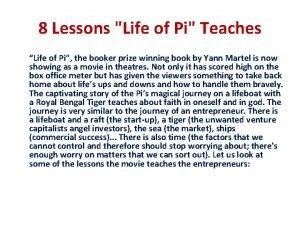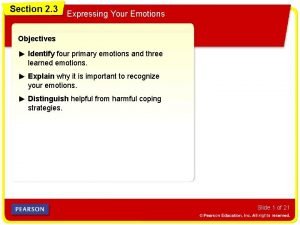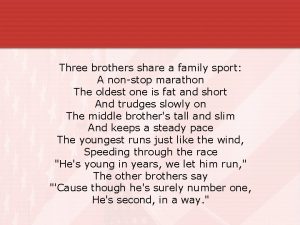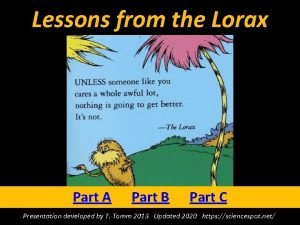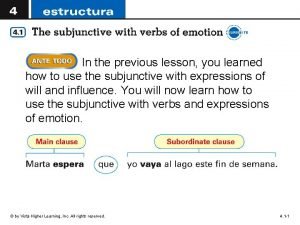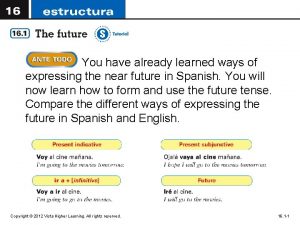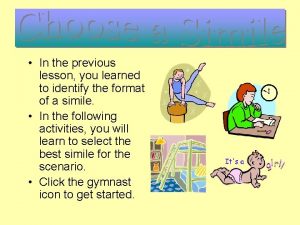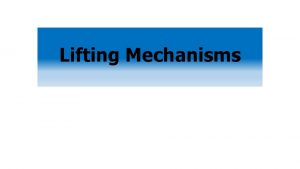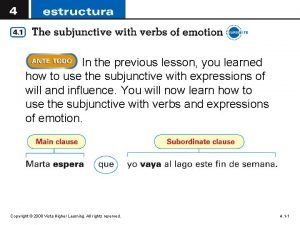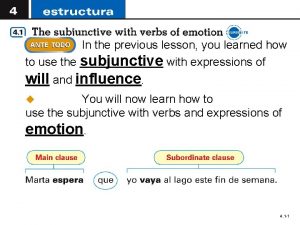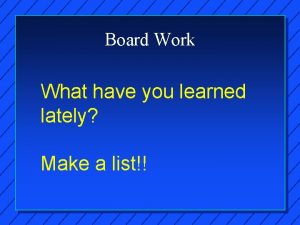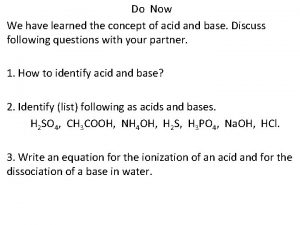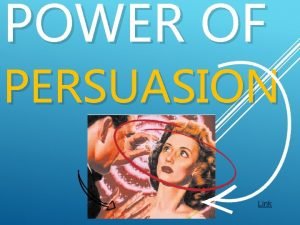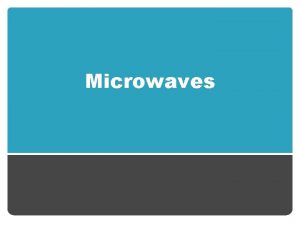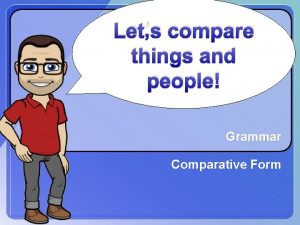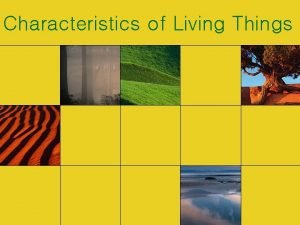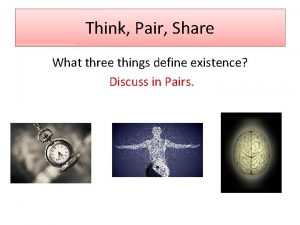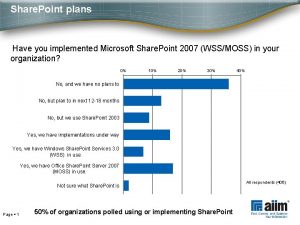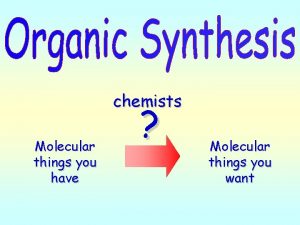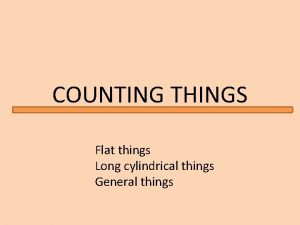Ch 7 Review Share THREE things you learned



























- Slides: 27

Ch. 7 Review Share THREE things you learned Monday with THREE different people -Landmark documents -Terminology Box 7. 2 -Difference in two types of fitness -Define the FITT acronym -Training principles -Difference in norm- & criterion-referenced testing 1 © 2009 Mc. Graw-Hill Higher Education. All rights reserved.

Chapter 8: Fitness Programs and Professions HPHE 1500 Dr. Ayers © 2009 Mc. Graw-Hill Higher Education. All rights reserved.

Introduction t. Government focus on importance of health & PA: v. Healthy People 2000 (1991) v. Surgeon General’s Report on PA & Health (1996) v. Healthy People 2010 (2000) v. Healthy People 2020 (2010) t National health objectives tracked for progress (T 8. 1) t Overarching goals relative to national health: v. Improve health of all people v. Eliminate health disparities between groups 3 © 2009 Mc. Graw-Hill Higher Education. All rights reserved.

Fitness Levels Among Children and Youth t. Fitness of U. S. youth questioned since the 1950’s t. Comparisons across decades v. Changing definitions of “fitness” difficult/inappropriate v. Different types of tests used t. Shift in focus: v. FROM: Improving fitness (outcome) v. TO: Increasing PA (process) t. Today’s youth underperform on: v Body composition (↑ levels of overweight/obesity) v Cardiovascular capacity 4 © 2009 Mc. Graw-Hill Higher Education. All rights reserved.

t. One’s health and fitness. . . personal responsibility? (Box 8. 1, p. 187) What about the environment in which we live (that we have created for ourselves)? What, how, where, and how much do we eat? How has PA been squeezed out of daily life? So what? Measures of childhood health/PA are predictive! 5 © 2009 Mc. Graw-Hill Higher Education. All rights reserved.

PA Patterns Among Children and Youth t. Sample key findings Ø HR readings indicate most are meeting ACSM’s recommendations for adult PA levels Ø Most do not get regular PE from a specialist Ø Only half of 12 -21 year-olds engage in vigorous PA regularly; 25% never do so Ø Boys are more active than girls Ø 6 -11 year-olds are the most active population group 6 © 2009 Mc. Graw-Hill Higher Education. All rights reserved.

Ø Steepest PA decline occurs between ages 12 -17 Ø Only 21% of adolescents participate in school Physical Education 1 or more days a week t. WHY? Ø Reduced access (“exclusionary” sport model) Ø Competing interests Ø “It’s no longer fun” Ø Alternative activity choices 7 © 2009 Mc. Graw-Hill Higher Education. All rights reserved.

t. What factors motivate adolescents? Ø Body shape, looks Ø Managing stress Ø Peer approval Ø Desire for independence From Sallis (1994) L Inactive teens become inactive adults. . . 8 © 2009 Mc. Graw-Hill Higher Education. All rights reserved.

Fitness & PA Levels Among Adults t. Difficult to assess/estimate fitness & PA levels t. Can be viewed from various perspectives: v. PA estimates range widely. . . (Fig. 8. 1, p. 191) v. Patterns of CVD risk factors among adults (Box 8. 2, p. 192) t. Inactive adults are twice as likely to die from CVD than active adults t. PA level is a more critical health indicator than fitness test results 9 © 2009 Mc. Graw-Hill Higher Education. All rights reserved.

t. Health at Every Size (www. welcoa. org) Ø Self-acceptance Ø Physical activity Ø Normalized eating (base intake on physiological hunger & fullness) t. Older adults, the good news: ØLive longer ØAre increasing PA levels ØMore commonly participating in resistance exercise t. Older adults, the bad news: Ø 85% of the 65+ age group 1+ one chronic disease Ø 35 -50% women 70+ have mobility problems ØIncur the highest amount of health-care costs 10 © 2009 Mc. Graw-Hill Higher Education. All rights reserved.

Fitness & PA Programs for Children and Youth t. Importance of school Physical Education programs is recognized by parents & federal gov’t t. CDC’s guidelines targets schools, delivery of Physical Education and Health Education programs, policies, personnel, environment/infrastructure, training of personnel, parental involvement, and evaluation as key elements (Box 8. 4, p. 197) ØSchool Physical Education programs alone cannot meet all guidelines ØPA opportunities must be created for all youth throughout communities 11 © 2009 Mc. Graw-Hill Higher Education. All rights reserved.

t Examples of creative program expansions: ØUse of school-wide daily PA breaks ØFitness remediation programs ØFour year fitness program ØDaily fitness programs ØIn-school fitness centers ØState-requirement approach ØSchool fitness clubs ØRequired fitness courses ØElective fitness courses 12 © 2009 Mc. Graw-Hill Higher Education. All rights reserved.

Fitness & PA for People With Disabilities t. Historically, PA programs had a rehab/medical focus t. Current efforts target people’s health t. Often, major barriers prevent access to PA t. With accommodations in place, PA health benefits realistic for people with disabilities t. PL 94 -142 has helped increase sport & other PA levels 13 © 2009 Mc. Graw-Hill Higher Education. All rights reserved.

AAHPERD Efforts to Promote Physical Activity and Fitness ØPhysical Best Educational arm of health-related fitness programming Ø Fitnessgram Assessment arm of health-related fitness instruction Ø Brockport Physical Fitness Test Adapted fitness test Ø Fit. Smart Test Cognitive assessment of health-related fitness knowledge 14 © 2009 Mc. Graw-Hill Higher Education. All rights reserved.

Worksite Fitness and Wellness Programs t. More commonplace over the past 25 years t. Can help reduce: ØHealth-care cost, employee turnover, & absenteeism t. Can help improve: ØEmployee productivity and morale t. Programs typically include: ØNutrition (e. g. , programs, guidance, weight management) ØFitness (e. g. , programs, facilities, testing) ØGeneral health (e. g. , healthy back programs, screenings) 15 © 2009 Mc. Graw-Hill Higher Education. All rights reserved.

National Efforts to Promote Fitness and Physical Activity t. Examples of Federal Government involvement since early 20 th Century: ØImprovement of fitness in military Ø 1956: President’s Council on Youth Fitness formed Now President’s Council on Fitness, Sport & Nutrition http: //www. fitness. gov/about/index. html Ø 1978: USDHHS > Exercise recognized as an important determinant of health status 16 © 2009 Mc. Graw-Hill Higher Education. All rights reserved.

Ø 1990: 34 National Health Objectives developed specifically for fitness and health Ø 1996: Surgeon General’s Report on PA & Health Ø 2000: “Promoting Better Health for Young People Through Physical Activity and Sport” published Ø 2001: CDC publishes Increasing Physical Activity: A Report on Recommendations of the Task Force on Community Preventive Services 17 © 2009 Mc. Graw-Hill Higher Education. All rights reserved.

Legislative Efforts to Improve Child and Youth Fitness t 2004: Federal School Lunch Act renewed. . . Targets nutrition, nutrition education and physical activity t. States have passed legislation that defines requirements for food services & time requirements for PA and Phys. Educ. t. HR 3257 (Fit Kids Act): Proposed amendment to No Child Left Behind t 2001: Carol M. White Physical Education Program (PEP) grant program initiated 18 © 2009 Mc. Graw-Hill Higher Education. All rights reserved.

Physical Fitness Instruction: By Whom? t. Who teaches in the almost 30, 000 health clubs in the US, that serve over 41 m members? t. Individual organizations do offer certification (e. g. , ACSM, IAR, NCSA, IDEA, AFAA) t. Value of such certification? . . Not all are created equally t 2003: National Board of Fitness Examiners formed to develop national standards & examination for fitness instructors (http: //nbfe. org) 19 © 2009 Mc. Graw-Hill Higher Education. All rights reserved.

Athletic Training t. National Athletic Training Association (NATA) www. nata. org t. Main function: Oversee AT certification process t. Preparation includes significant clinical component t. Highly rigorous examination process 20 © 2009 Mc. Graw-Hill Higher Education. All rights reserved.

ACSM Fitness-Instruction Certification t. Offers two certification tracks: Health and Fitness Clinical t. Also provides continuing education for its members 21 © 2009 Mc. Graw-Hill Higher Education. All rights reserved.

Strength & Conditioning Coach Qualifications t. International non-profit organization with 30, 000 members from 52 countries t. Certifies strength and conditioning specialists t. Certification requites degree in Ex. Science, CPR certif, and 2+ yrs. of employment as G. A. at NSCA-recognized program t. NSCA released new standards & guidelines in 2009 http: //www. nsca-lift. org/Publications/SCStandards. pdf 22 © 2009 Mc. Graw-Hill Higher Education. All rights reserved.

AFPA Certification t. American Fitness Professionals and Associates (AFPA) certifies personal trainers and fitness professionals via distance education (http: //afpafitness. com) t. Certification in 23 specializations, such as: Personal Trainer Yoga Instructor Senior Strength Specialist Pre-/Post-natal Ex. Specialist Pilates Instructor 23 © 2009 Mc. Graw-Hill Higher Education. All rights reserved.

ACE Certification t. American Council on Exercise (ACE) (www. acefitness. org) Has certified > 40, 000 fitness professionals in more than 100 countries t. Areas of certification: Ø Ø Clinical Exercise Specialist Advanced Health & Fitness Specialist t. Certification eligibility requirements: Ø 18 years of age ØAdult CPR certification ØDegree in Ex. Science (or related field) ØCurrent ACE Personal Trainer certification Ø 300 hours of related work experience 24 © 2009 Mc. Graw-Hill Higher Education. All rights reserved.

Physical Therapy t. American Physical Therapy Association (APTA) is main organizing body t. Requires extensive specialized training at grad school level t. Certification is governed at the state level t. Specialization certification also possible in: Neurology Pediatrics Cardio-pulmonary Orthopedics Sports Phys. Therapy Geriatrics 25 © 2009 Mc. Graw-Hill Higher Education. All rights reserved.

Master’s Degree in Fitness t. Typical program specializations include: ØAdult Fitness ØCardiac Rehabilitation ØStrength Development ØCorporate Fitness ØExercise Physiology t. Most require ACSM Certification t. Typical prerequisite courses include: ØAnatomy, Physiology and Exercise Physiology ØChemistry, Math, Physics, and Measurement ØStrength Development ØCorporate Fitness 26 © 2009 Mc. Graw-Hill Higher Education. All rights reserved.

Summary Share one thing you learned today Monday: Ch 7 -8 quiz Ch 10 for class 27 © 2009 Mc. Graw-Hill Higher Education. All rights reserved.
 In three minutes write
In three minutes write You must unlearn what you have learned
You must unlearn what you have learned Lesson in life of pi
Lesson in life of pi 3 things you can cut answer
3 things you can cut answer Three uncles of rizal who influenced him
Three uncles of rizal who influenced him The three learned emotions are grief shame and
The three learned emotions are grief shame and Three learned emotions
Three learned emotions Three brothers share a family sport
Three brothers share a family sport What was the job of the lorax
What was the job of the lorax What you learned in the previous lesson
What you learned in the previous lesson I have learned that cause and effect
I have learned that cause and effect I have already learned
I have already learned Human act modifiers
Human act modifiers In the previous lesson
In the previous lesson Simple lifting mechanisms
Simple lifting mechanisms In this unit you will
In this unit you will In our previous lesson i have learned about
In our previous lesson i have learned about Osfm lesson plans
Osfm lesson plans What is something you have learned lately
What is something you have learned lately In this unit you learned to talk about home maintenance
In this unit you learned to talk about home maintenance Now that you have learned about this concept
Now that you have learned about this concept Pyramid hesd
Pyramid hesd The seven life processes of living things
The seven life processes of living things If i have three wishes they would be
If i have three wishes they would be When montresor offers the medoc wine to fortunato
When montresor offers the medoc wine to fortunato Type of ad
Type of ad What molecules are microwaves most attracted to?
What molecules are microwaves most attracted to? Let's compare things
Let's compare things


